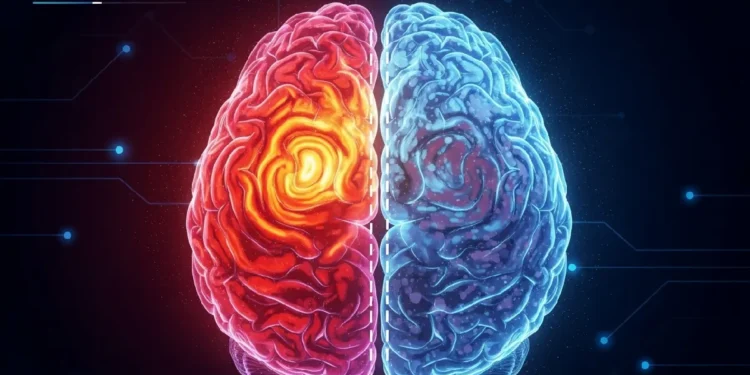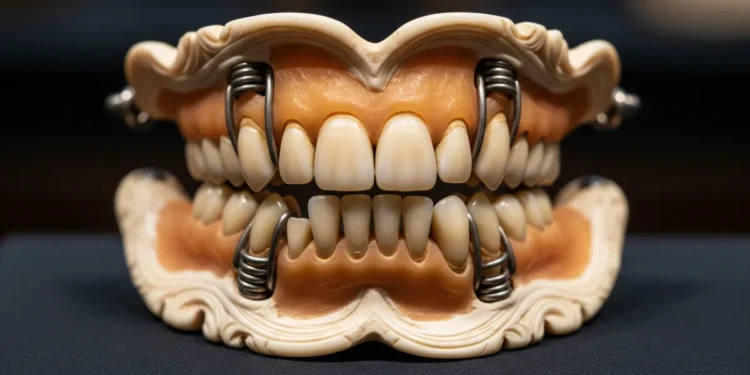Traces the 10% Brain Myth from early misquotes, media amplification, to pop-psychology exploitation — then uses neuroscience evidence to show why the claim is false.
Table of Contents
Introduction
The 10% Brain Myth is the most successful and resilient lie in the history of popular science. It’s a statistic that feels true, whispered in classrooms, shouted in Hollywood blockbusters, and sold as gospel in self-help seminars. We have all heard it: a simple, tantalizing claim that a vast, dormant continent of genius lies waiting within our skulls, locked behind a mysterious 90% barrier. This idea is not just a harmless piece of trivia; it is a foundational myth that has spawned a multi-billion-dollar industry, fueled our deepest insecurities, and profoundly distorted our understanding of the very organ that makes us human.
This persistent neuromyth thrives because it tells us exactly what we want to believe: that superhuman potential is just one simple trick away. It’s a comforting explanation for our struggles and a seductive promise of untapped greatness. But it is, unequivocally, a fiction. The consequences of the 10% Brain Myth are not trivial; they represent a collective failure of critical thinking and create fertile ground for pseudoscientific exploitation. Believing in this flawed premise makes us vulnerable to cynical marketing and distracts from the real, scientifically-backed methods of cognitive improvement.
This article will dismantle that fiction, piece by piece. First, we will trace the murky origins of the 10% Brain Myth, from early psychological misquotes to its amplification in media and pop culture. We will expose the lucrative industry built upon this falsehood. Then, we will systematically debunk the claim with nine irrefutable lines of evidence from modern neuroscience—from the definitive proof of brain scans and the logic of evolution to the tragic lessons of brain injury. It’s time to stop rethinking the 10% Brain Myth and start recognizing it for what it is: a century-old lie that has held our imagination captive for far too long.
The Murky Origins of a Century-Old Neuromyth
Like many persistent fictions, the 10% Brain Myth doesn’t have a single, definitive origin but rather a trail of misinterpretations and convenient misquotes. The trail often begins with the revered American psychologist William James, who in the early 20th century wrote about the vast, untapped potential of human beings. James speculated that we are only making use of a small part of our possible mental and physical resources. However, his philosophical observation about our latent energy was never a quantitative neuroscientific statement. The leap from untapped potential to unused physical brain matter is a distortion that marks the first step in the creation of the flawed 10% Brain Myth.
The myth found further footing in the scientific work of neuroscientist Karl Lashley in the 1920s and 1930s. Lashley conducted experiments where he removed significant portions of rats’ cerebral cortexes and found they could still relearn how to navigate mazes. From this, some concluded that large brain areas were “silent” or non-functional. This was a crude misreading of his findings, which actually pointed toward the brain’s incredible plasticity and the distributed nature of memory. The idea that certain parts of the brain did nothing simply because their function wasn’t immediately obvious was a fallacy that the 10% Brain Myth eagerly absorbed.
Perhaps the most influential factor in cementing the myth was the false attribution to Albert Einstein. To this day, the claim is frequently credited to him as a way to lend it an air of profound authority. Yet, there is no record of Einstein ever making such a statement. His name was likely attached to the myth posthumously to make it more compelling, transforming a vague notion into a supposed fact endorsed by a genius. This act of intellectual appropriation demonstrates how the 10% Brain Myth transitioned from a scientific misunderstanding into a powerful piece of cultural folklore.

How Media and Pop Culture Cemented the 10% Brain Myth
If the early 20th century gave birth to the 10% Brain Myth, it was media and popular culture that raised it into the unkillable giant it is today. A pivotal moment came with Dale Carnegie’s immensely influential 1936 book, How to Win Friends and Influence People. In his foreword, Lowell Thomas paraphrased William James’s idea of untapped potential, stating that the average person “develops only 10 percent of his latent mental ability.” While still focused on potential, not physical brain use, Carnegie’s massive audience absorbed the simplified number. This act of translation from academic theory to self-help gospel was critical in popularizing the flawed 10% Brain Myth.
From there, fiction took the baton and sprinted. Hollywood, in particular, fell in love with the myth’s dramatic possibilities. Films like Limitless (2011) and Lucy (2014) transformed the 10% Brain Myth from a simple misunderstanding into a thrilling premise for superhuman abilities. These stories present compelling fantasies where a pill or a cosmic event can “unlock” the remaining 90%, granting characters powers like photographic memory, predictive abilities, and telekinesis. While entertaining, this narrative device powerfully reinforces the myth, making it seem not only plausible but desirable, and cementing it as a core trope in modern science fiction.
Beyond fiction, news articles and magazines have played a significant role in perpetuating the consequences of the 10% Brain Myth by repeating it uncritically. For decades, the myth has been presented as a “fun fact” in headlines, trivia sections, and even educational materials. This casual, unexamined repetition by sources people perceive as trustworthy has been incredibly damaging. By framing it as established knowledge, the media has absolved the public of any need for critical thought, allowing a baseless claim to become entrenched as common sense and ensuring that rethinking the 10% Brain Myth would be an uphill battle.
The Lucrative Industry Built on a Flawed Premise
Where there is a widespread insecurity, a profitable industry is sure to follow. The 10% Brain Myth created the perfect foundation for the multi-billion-dollar “brain training” and self-help markets. Companies selling cognitive enhancement apps, neuro-linguistic programming courses, and nootropic supplements have built their entire business model on this flawed premise. They promise to help you “unlock” that dormant 90%, framing your current cognitive abilities as a mere fraction of what they could be. The entire industry’s sales pitch hinges on the consumer believing in the very existence of the 10% Brain Myth.
The marketing language employed is both masterful and predatory. It preys directly on the universal human desire for self-improvement and the nagging feeling that we could be doing more. Phrases like “tap into your hidden potential” or “unleash the genius within” are deliberately crafted to exploit this insecurity. This rhetoric positions a normal, healthy brain as fundamentally deficient and in need of a commercial solution. The narrative suggests that personal and professional limitations aren’t complex issues to be worked through but simply the result of a biological switch that needs flipping—a switch their product can control.
The financial consequences of the 10% Brain Myth are staggering. Consumers spend billions of dollars annually on unproven products and programs that offer a shortcut to cognitive greatness. From expensive seminars promising to rewire your thinking to monthly subscriptions for brain games with dubious real-world benefits, the money flows freely. This represents a massive misallocation of resources, diverting time and money away from legitimate, evidence-based methods for self-improvement, like education, exercise, and mental health care. The only thing being unlocked is the customer’s wallet, proving the 10% Brain Myth is less a scientific theory and more a highly effective marketing tool.
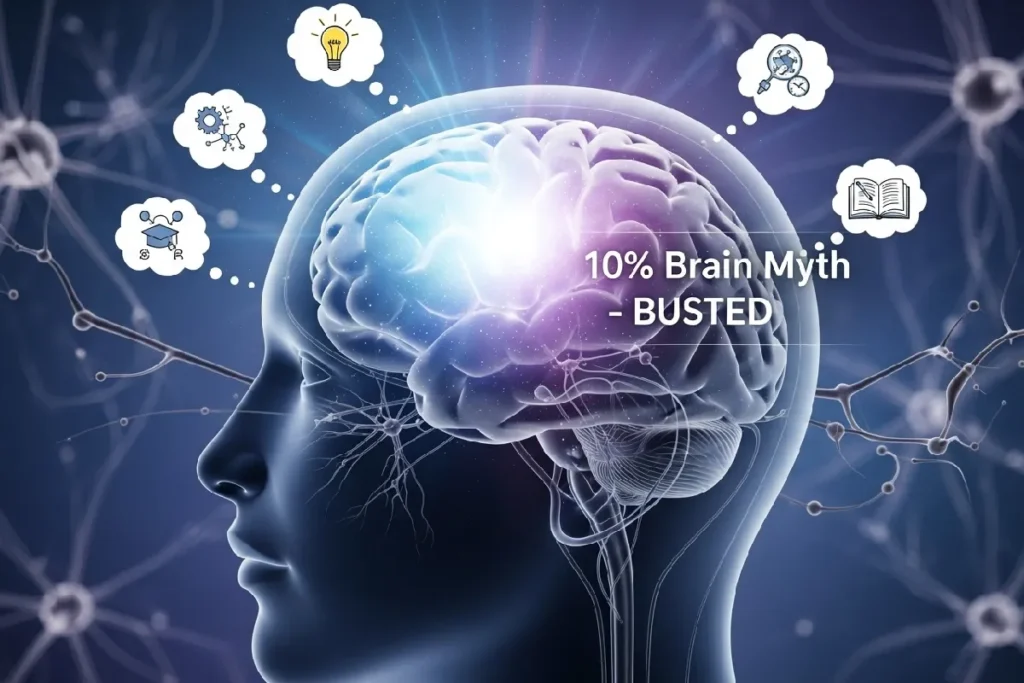
The Evidence from Within: What Brain Scans Reveal
Modern neuroscience has provided us with a direct window into the living brain, and what it shows us is a decisive refutation of the 10% Brain Myth. Technologies like functional magnetic resonance imaging (fMRI) and positron emission tomography (PET) allow scientists to observe brain activity in real time. These scans don’t reveal a vast, dark, and silent continent of unused tissue. Instead, they show that even for the simplest actions, like clenching your fist or thinking a thought, activity flares up across multiple, widespread regions of the brain. The idea that 90% of our brain lies dormant is simply not supported by the visual evidence.
The brain operates through complex, interconnected networks, and while different tasks emphasize different networks, no part of the brain is ever truly “off.” Think of it like an orchestra: during a violin solo, the brass and percussion sections may be quieter, but they are still present, alert, and contributing to the overall piece. Similarly, when you read a book, your visual cortex, language centers, and frontal lobes are highly active, but other areas are still humming along, monitoring sensory input and maintaining bodily functions. There are no unused sections waiting for a conductor; the entire orchestra is always engaged.
This continuous activity is undeniable even when we are doing nothing at all. During periods of rest, the brain’s “default mode network” is highly active, engaging in processes like self-reflection and memory consolidation. Even in deep sleep, the brain is furiously at work, clearing out metabolic waste and strengthening memories. Critical areas like the frontal cortex and the limbic system remain engaged throughout the night. This constant, energy-intensive activity is the biological reality, making the flawed 10% Brain Myth not just an exaggeration, but a direct contradiction of what we can plainly see our brains doing every second of every day.
An Evolutionary Case Against Wasted Resources
Beyond modern imaging, one of the most compelling arguments against the 10% Brain Myth comes from simple evolutionary logic. The human brain is a profoundly expensive organ to maintain. While it accounts for only about 2% of our total body weight, it consumes a staggering 20% of our daily energy intake. For our ancestors, who lived in a world of scarce resources and constant survival challenges, every calorie was precious. The idea that evolution would permit the development of such a metabolically greedy organ only to let 90% of it sit idle is not just inefficient—it’s a biological absurdity.
Natural selection is a relentless process of optimization. Traits that provide a survival advantage are passed on, while those that are wasteful or burdensome are eliminated over time. If having a large brain was evolutionarily beneficial, it’s because all of its parts were being put to use for critical functions like tool-making, social cooperation, and problem-solving. A brain that was 90% useless baggage would have been a significant survival liability, not an advantage. Rethinking the 10% Brain Myth from this perspective reveals it as a complete contradiction of evolutionary principles.
Therefore, the very existence of our large, complex brains is a testament to their full utilization. The evolutionary pressures that shaped us would have strongly selected against any organism that wasted precious energy sustaining a non-functional organ. The human brain isn’t a luxurious, half-empty mansion; it’s a lean, efficient, and fully-occupied command center. From a purely biological and logical standpoint, the entire concept of the 10% Brain Myth is untenable. Evolution simply doesn’t do waste on that grand a scale.
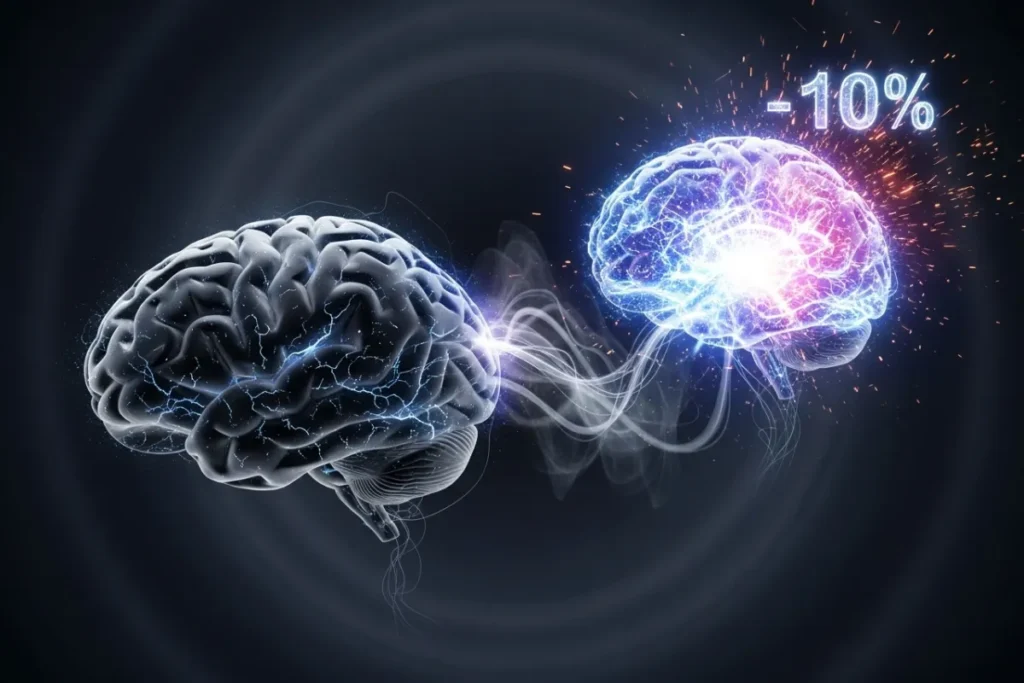
The Brain at the Cellular Level: No Neuron Left Behind
Zooming in to the microscopic level reveals another definitive nail in the coffin for the 10% Brain Myth. The brain develops and maintains itself based on a strict “use it or lose it” principle. During childhood and adolescence, our brains undergo a critical process called synaptic pruning. This isn’t the brain adding more capacity; it’s the brain getting rid of what it doesn’t need. Connections between neurons that are frequently used are strengthened, while those that lie dormant are systematically eliminated to improve overall efficiency. The brain’s core developmental strategy is to discard unused components, making the idea of preserving a vast, inactive 90% nonsensical.
This principle extends throughout our lives. Brain cells that are not actively engaged in neural circuits will not be maintained. If a neuron fails to make meaningful connections or stops receiving signals, it triggers a process of programmed cell death called apoptosis. Simply put, unused brain cells degenerate and die off. If the 10% Brain Myth were true, autopsies of adult brains would reveal massive areas of decay, akin to a withered, unused muscle. The complete absence of such evidence in neurological science is a powerful testament to the fact that our neurons are in a constant state of activity.
Ultimately, the cellular architecture of the brain is built for ruthless efficiency, not for hoarding unused resources. Every synaptic connection, every neural pathway, exists because it serves a purpose. A brain where 90% of the cells were inactive wouldn’t be a reservoir of untapped potential; it would be a diseased organ in a state of advanced decay. The consequences of the 10% Brain Myth are that it ignores this fundamental biological reality, replacing the elegant truth of an efficient, fully-utilized brain with a convenient but completely baseless fiction.
The Unfortunate Proof: What Brain Damage Teaches Us
Perhaps the most tragic and compelling evidence against the 10% Brain Myth comes from the field of clinical neurology. Every day, doctors witness the devastating consequences of damage to even minuscule portions of the brain. A stroke in a tiny, specific area of the left hemisphere can completely erase a person’s ability to speak or understand language. A small lesion on the occipital lobe can cause blindness, and an injury to the cerebellum can destroy motor control and balance. The fact that no part of the brain can be damaged without causing some functional deficit is a clear, real-world demonstration that all parts of the brain are crucial.
Let’s apply the flawed logic of the 10% Brain Myth to this reality. If we only used a tenth of our brain, then we should be able to withstand significant brain damage in the other 90% without any noticeable effect. It would imply a massive, useless buffer zone that could absorb trauma, disease, or stroke with no ill effects. This is patently, and unfortunately, false. The clinical evidence is overwhelming: every square centimeter of the brain is assigned a function, and when it is lost, the consequences are immediate and often permanent.
In essence, the entire field of neurology is a continuous, living refutation of the 10% Brain Myth. Neurosurgeons meticulously map the brain to avoid damaging critical areas during operations because they know there is no “safe” or “unused” territory to cut through. The very idea that our skulls house a vast, dormant reserve of brain matter is an insult to the lived experience of every single person who has suffered from a brain injury. The consequences of the 10% Brain Myth include not just a misunderstanding of science but a trivialization of the brain’s profound and comprehensive fragility.
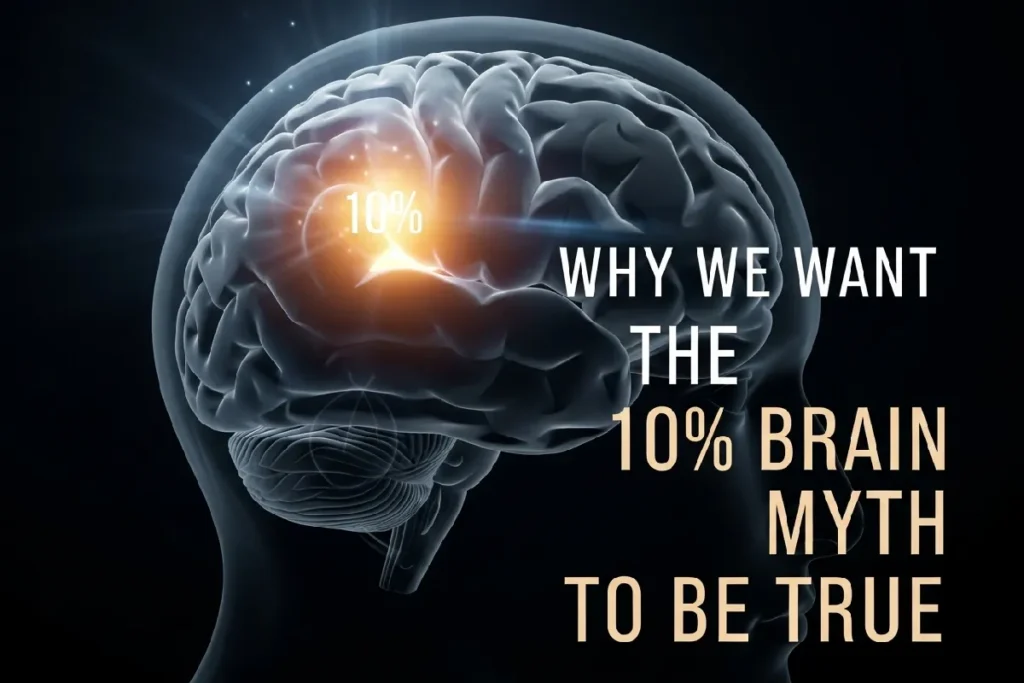
The Psychological Allure: Why We Want the Myth to Be True
If the scientific evidence against the 10% Brain Myth is so overwhelming, why does it refuse to die? The answer lies less in science and more in psychology. The myth’s primary appeal is its potent cocktail of hope and absolution. It offers a simple, almost magical explanation for our perceived limitations and failures. The idea that we are not living up to our potential because of a biological technicality, rather than complex personal or circumstantial reasons, is deeply comforting. It suggests that our shortcomings are not our fault and that a vastly more capable version of ourselves is just waiting to be switched on.
This narrative of instant transformation is far more seductive than the mundane reality of self-improvement. The 10% Brain Myth provides the foundation for a compelling fantasy: that with one simple trick, a secret pill, or a special training program, we can achieve superhuman abilities. This is the stuff of blockbuster movies and bestselling novels, and it’s a much more attractive story than the truth—that meaningful growth is a slow, difficult, and often frustrating process of consistent effort. Rethinking the 10% Brain Myth means giving up this alluring shortcut in favor of hard work, which many are reluctant to do.
Ultimately, believing in the flawed 10% Brain Myth provides a profound psychological comfort. It fosters the belief in a vast, untapped reservoir of potential that is easily accessible, which can feel incredibly empowering. This sense of latent power offers a buffer against feelings of inadequacy and a hopeful solution for overcoming life’s challenges. The myth transforms us from being merely human into being superheroes in waiting. It’s a powerful and persistent fiction because it tells us exactly what we want to hear about ourselves, making it one of the most resilient lies in popular science.
Moving Past the Myth: The Real Path to Cognitive Enhancement
It is time to permanently discard the flawed 10% Brain Myth and embrace a far more exciting and scientifically accurate concept: neuroplasticity. True cognitive enhancement doesn’t come from unlocking some dormant, mythical portion of the brain. It comes from the brain’s real and remarkable ability to reorganize itself by forming new neural connections throughout life. Our brains are not static, half-used hard drives; they are dynamic, constantly adapting networks that are physically changed by our thoughts, actions, and experiences. This is where our true potential lies—not in a fictional 90%, but in our infinite capacity to learn and grow.
Instead of chasing the shortcuts promised by the myth, we should focus on the evidence-based methods that genuinely support brain health and function. Lifelong learning, whether it’s acquiring a new language or mastering a musical instrument, builds new pathways and strengthens cognitive reserve. Regular physical exercise is one of the most powerful tools we have, boosting blood flow, reducing inflammation, and stimulating the release of growth factors that help create new neurons. This, combined with proper nutrition that provides the fuel for our energy-intensive brains, is the real formula for cognitive improvement.
Ultimately, the most damaging consequence of the 10% Brain Myth is that it distracts us from the truth. It encourages us to waste money on fraudulent products and fosters a fundamental misunderstanding of the magnificent, fully-active organ in our skulls. By moving past this persistent neuromyth, we can stop searching for a mythical switch to flip and start engaging in the real, rewarding work of building a better brain through scientifically-supported habits. The power to improve our minds is real, but it’s found in disciplined effort, not in a century-old lie.
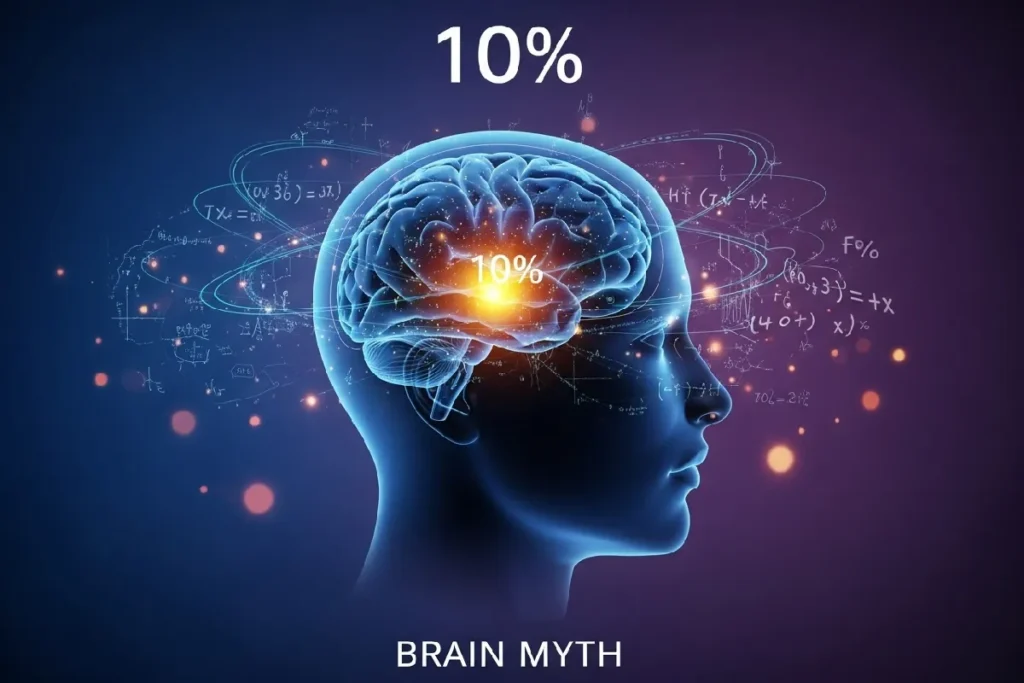
Conclusion
We have traced the insidious journey of the 10% Brain Myth, from its murky origins in misread psychological theories to its viral spread through popular media and Hollywood blockbusters. We saw how this fiction was co-opted by a lucrative self-help industry eager to sell a cure for a condition that never existed. This journey reveals not a scientific fact, but a cultural phenomenon—a rumor that became a gospel through sheer repetition and its alignment with our deepest hopes for an easy path to self-improvement. It became a powerful story, but a story nonetheless.
Against this narrative, we stacked a mountain of irrefutable scientific evidence. The sheer evolutionary cost of maintaining a brain makes a 90% useless organ a biological impossibility. Modern brain scans reveal a symphony of constant, widespread activity, leaving no room for a silent majority of neurons. On a cellular level, the brain’s “use it or lose it” principle ensures no cell is left behind, while the devastating reality of brain damage proves every single region is critical. The verdict of neuroscience is not ambiguous; it is absolute. The flawed 10% Brain Myth is unequivocally false.
Therefore, the challenge is not to unlock a mythical reservoir of brainpower, but to consciously reject this disempowering falsehood. The true path to enhancing our cognitive abilities lies in embracing the scientifically-validated concept of neuroplasticity. We must trade the fantasy of a magic switch for the rewarding reality of consistent effort—through lifelong learning, physical health, and intellectual curiosity. True potential isn’t waiting to be found; it is forged. It’s time to stop looking for the missing 90% and start appreciating and cultivating the incredible, fully-functioning 100% we already possess.
